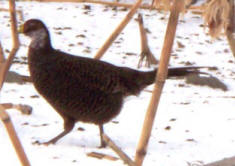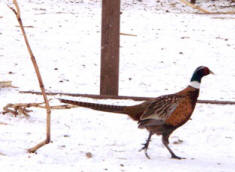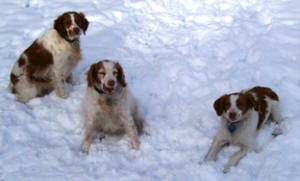RING-NECKED PHEASANTS
What is a ring-necked pheasant? Well, it is a bird and, I might add, a very tasty one. Yes, it is clean for us to eat and, in fact, if you hunt them yourself or get them from someone who does hunt, they are quite healthy since there is not usually a whole lot of fat on them. Quite a few folks will just cook the breast meat as the legs can be quite tough (much like a wild turkey).
It is actually the state bird of South Dakota and is only one of three state birds which are not species native to the United States. In this case, the pheasant is native to Asia but very common here in our country now. It is a very popular “game bird.”
When man imports creatures to lands where they don’t naturally exist, he often brews trouble. Now we should know this anyway, right? I mean, if Yahweh wanted something in a certain place, wouldn’t He have put it there? You’ve heard it said, “If Yahweh meant for men to fly, we’d have wings.” Now the only people that say that, of course, are those who do not want to fly in airplanes and we also know that Yahweh gave people the means, intelligence and wherewithal to make airplanes, too!
If you check the impact and spread of the rabbit in Australia, the red deer in New Zealand, and the English sparrow and starling in the United States, you may find that they became quite substantial “pests.” The ring-neck pheasant is an import, too, but unlike the species mentioned above, it hasn’t become a pest. In fact, this Asian native has proven to be a fine member of North America’s wildlife community. The ringneck is the hunter’s bird—imported, stocked and transferred to suitable habitat throughout the nation by wildlife departments. Today, the ringneck benefits us all, providing in-the-field enjoyment to hunters, birdwatchers and nature lovers of all types (and let’s not forget they are quite tasty!).
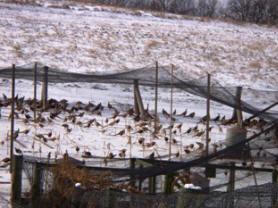 Some folks raise pheasants on their own property in a small, fully fenced-in area (even fenced at the top). They are raised for hunting purposes where they then transport the fully grown, matured birds to an area for hunters to hunt them. In some areas, in Pennsylvania for instance, if you put pheasants out to hunt and do not get them, they are “free” birds. You are not allowed to catch them with nets, for example, to put them out another day. Now if they were to fly back into a pen, that would be different because they came back of their own accord.
Some folks raise pheasants on their own property in a small, fully fenced-in area (even fenced at the top). They are raised for hunting purposes where they then transport the fully grown, matured birds to an area for hunters to hunt them. In some areas, in Pennsylvania for instance, if you put pheasants out to hunt and do not get them, they are “free” birds. You are not allowed to catch them with nets, for example, to put them out another day. Now if they were to fly back into a pen, that would be different because they came back of their own accord.
The species is found throughout the United States except in the southeast (too hot?), parts of the southwest (too hot?) and the far north (too cold?). Good populations exist in farming regions of the Midwest and the northeast. The ring-neck is an abundant permanent resident in Pennsylvania’s agricultural areas. The ring-neck's scientific name is Phasianus colchiucus (hmm, can you pronounce that?), and it is a member of the Phasianidae, or pheasant, family. Closely related to quails and partridges, the ring-neck belongs to the order Galliformes, which also includes turkeys, quail, grouse, ptarmigan (now there’s one to look up) and prairie chickens.
Biology
An adult male weighs 2 ½ to 3 ½ pounds and an adult female 2 pounds. Males are called roosters, cocks or cockbirds; females are hens. The standing height of a rooster is about one foot and its length, from beak to tail tip, averages 36 inches. Hens are slightly smaller. A pheasant is long-legged and rangy through the body with a long, pointed tail (about 20-23 inches long!) and short, rounded wings.
|
|
|
|
Can you see the difference between the male and female? Which one is which? |
|
A hen’s plumage is a subtle, camouflaging mixture of brown, black and gray. In contrast, a rooster’s feathers are a beautiful mix of reds, browns, golds and black. A rooster has scarlet cheek patches, a white neck ring (hmmm, think that is where “ring-necked” came from?) usually interrupted in the front, and iridescent greenish-black head, golden-brown breast, and a greenish-gray or bluish rump and lower back. Tail feathers of both sexes are brown with black bars.
|
|
|
This is one of many types of "bird dogs." They are called "Brittany Spaniels." |
The crowing of a rooster is distinctive: a loud double squawk followed by rapid muffled wingbeats which may or may not be audible, depending on distance. Males crow most often during mating season, especially at sunrise and sunset; they may also emit a loud cackle when flushed into flight. Their sound is almost like a loud, harsh "koork-KOK." Hens are normally silent. Did you ever hear the phrase “flushed into flight”? When hunting for pheasants, dogs are used to point where the bird is, then (ideally on your command) they move in on the bird “flushing” it; in other words, getting so close to make it fly (or run at times). Some bird dogs will retrieve it when shot and some will even “retrieve” it when no one shot, but the dog will get it and bring it back to you.
Pheasants eat weed seeds (ragweed, smartweed, foxtails, etc.), grains (corn, wheat, barley, oats, beans and buckwheat), fruits and berries (raspberries, dewberries, strawberries, thornapples, barberry), shoots, leaves, grasses, rose hips and insects. They find a lot of their food by scratching through ground litter. Gee, no wonder they are clean to eat! Look at what they eat….
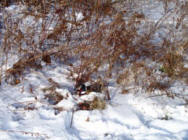
Like most birds, ringnecks have sharp senses of hearing and sight. Extremely wary in autumn, they stick to dense cover when hunted heavily. During spring and summer they can be seen strutting across freshly mowed fields and along roadsides. When pursued, pheasants would rather run than fly (remember how we said some hunting dogs will bring back a bird nobody shot at?), dodging nimbly into heavy cover—brambles, honeysuckle, or multiflora rose. When cornered or surprised, they take to the air. Strong fliers over short distances, they attain a maximum speed of 45 m.p.h. in the open. Outside of breeding season (when roosters stake out individual territories) and brood-raising periods, pheasants are relatively gregarious (here’s another word to look up), roosting in groups. In Pennsylvania, pheasants often roost in trees. The averages pheasant ranges within one square mile. You can see in the picture above left how good they are at hiding.
Roosters claim individual breeding territories each spring. A rooster’s courtship display includes spreading his tail and wings and strutting; his red cheek patches are swollen, his head is held low, and his neck feathers are ruffled. With persistence, he will collect a harem of up to a dozen hens (4-5 females per male is probably the average overall, with 8-12 hens per rooster in our primary range). Breeding begins in late March or early April and may extend into August. The male does not help incubate eggs or raise young.
|
|
|
|
|
|
|
|
|
|||
|
Pheasant Tracks: Next time you are out in a field, watch for tracks and see if you can identify pheasants in your area. |
||||
Nesting occurs from April to August. A hen selects a nest site on the ground in a hayfield, a weedy field, an overgrown pasture, or a brushy fence-row. A natural hollow (or one scraped out by the hen) is lined with weeds, grasses and leaves. Surrounding vegetation helps conceal both the nest and the laying or brooding bird.
The female lays 6-15 eggs (average is 10-12) over a two-week period. Eggs measure approximately 1 1/3 x 1 2/3 inches and are light tan to pale olive green in color. Incubation is usually postponed until the last egg is laid, so all eggs receive equal incubation time and hatch on the same day. If eggs are destroyed by farm operations, predators, fires or floods, hens may re-nest, some even making three attempts.
The eggs hatch after 23 or 24 days of incubation. Most clutches hatch by early July. Like the young of other gallinaceous (Gallinaceous birds are heavy-bodied ground-feeding domestic or game birds) species, pheasant chicks are precocial (which means “covered with down, their eyes open”), able to run about and eat as soon as their down dries. Chicks depend on the hen to shelter them from cold and rain (she does this by brooding, or sitting on top of them). Hens brood at night until young are able to roost in trees. Instinctively, chicks squat and remain motionless at a signal given by the hen; their coloration, tan with darker brown streaking, conceals them well. Foxes, raccoons, crows, weasels, house cats, dogs and hawks prey on the young.
The hen guides her chicks in food-finding. Insects, plentiful and high in protein, are a good early food. By two weeks of age, chicks can fly short distances; after six weeks, their adult plumage starts to come in; and by autumn, birds of the year look like adults. Young roosters can be told from older males by the length and hardness of their spurs, appendages growing out from the backs of their legs. In young birds, the spurs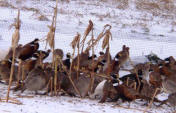 are relatively soft, blunt and short (a quarter-inch or less). Older roosters have hard, sharp spurs up to an inch in length from spur tip to the front of the leg. (Believe me, they HURT, too, if they get you with their spurs when you try to catch them inside their pens!)
are relatively soft, blunt and short (a quarter-inch or less). Older roosters have hard, sharp spurs up to an inch in length from spur tip to the front of the leg. (Believe me, they HURT, too, if they get you with their spurs when you try to catch them inside their pens!)
In winter, pheasants may form flocks. During inclement weather, they stick to thick protective cover of conifers, brushy sloughs, or forests overgrown with vegetation.
Population
The first successful pheasant introduction to North America was a release of approximately 30 birds in Oregon’s Willamette Valley in 1881. Many of America’s ring-necks have descended from these 30.
Habitat
Prime pheasant habitat is farmland that has occasional weed fields; blackberry, sumac and honeysuckle patches; swamp edges and marshy depressions grown up in cattails, grass and sedge; and overgrown drainage ditches. Clean-farming practices, where every bit of ground is put into production can reduce the diversity of food and cover which pheasants prefer.
Winter food and cover are important to local pheasant populations. Good foods are thornapples, apples, rose hips, skunk cabbage, ragweed, burdock, grapes, grasses, green vegetation and Japanese barberry; these, along with grain (especially waste corn left by mechanical harvesters) help birds over winter. Pheasants locate food in areas melted or blown free of snow, or by scratching. Pines provide excellent cover for roosting and daytime resting. Pheasants also seek out densely vegetated marsh or creek side areas during bitter weather.
Farmers can manage their land to produce more pheasants. Strips of corn may be left unharvested (5-10 rows next to cover are adequate); unpicked soybeans make good summer, fall and winter cover, and the beans are eaten from fall to spring. Forest edges can be cut to increase low, brushy growth, which makes good cover. Autumn olive, honeysuckle and pine plantings also improve cover. However, these things, of themselves, will not increase the pheasant population. Safe nesting cover will. This is the most important factor when bird numbers fluctuate widely from year to year. To reduce nesting losses, farmers should delay their first alfalfa cutting until the end of June.
Given adequate food and protective cover, ring-necks can pull through rough winters. They are hardy birds and, like all wildlife, have keen survival instincts.
HalleluYAH!
(A special thank-you to the Pennsylvania Game Commission for permitting us to use information they have gathered over the years!


